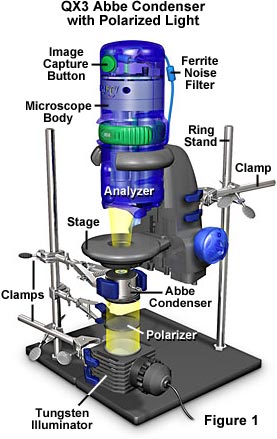Advanced Condenser Systems: Abbe Condensers
Polarized Light
Digital Image Gallery
Polarized light images of recrystallized anisotropic chemicals (this includes a majority of all chemicals) display beautiful patterns and colors as a result of the birefringent character of their crystalline structure. Configuration of the QX3 microscope as illustrated in Figure 1 allows imaging of specimens using polarized light microscopy.

To configure the QX3 microscope for polarized light, a polarizer is placed beneath the substage condenser and oriented such that polarized light exiting the polarizer is plane-polarized with a vibration direction that is east-west with respect to the optical axis of the microscope stand. Polarized light enters the anisotropic crystal on the microscope stage where it is refracted and divided into two separate components vibrating parallel to the crystallographic axes and perpendicular to each other. The polarized light waves then pass through the objective before reaching a second polarizer (usually termed the analyzer) that is oriented to pass a polarized vibration direction perpendicular to that of the substage polarizer. The analyzer is cut from a sheet of polarizing film and taped to the objective lens cover on the microscope body. To record digital images with a full-wave retardation plate, the plate is taped into place anywhere between the specimen and the analyzer. Refer to our section on polarized light microscopy utilizing the QX3 microscope for detailed information about polarizer placement.
Aspirin - (Specimen 1) This mild pain reliever, originally derived from the bark of willows, is also proving to be useful as an anticoagulant, preventing or reducing the severity of heart attacks and stroke.
Aspirin - (Specimen 2) Aspirin is a salicylic acid acetate with anti-inflammatory and antipyretic properties that also acts as a highly effective non-opiate analgesic. The drug crystallizes in the form of a white, needle-like powder with only a faint odor.
Beta-Carotene - A precursor to Vitamin A, this conjugated polyene also serves as a precursor that can be enzymatically converted into vitamin A in most animals and man. Although vitamin A is not present in any plants, the beta-carotene precursor can be found in carrots, pumpkins, spinach, squash, watermelon, asparagus, broccoli, and cantaloupe.
Caffeine - Coffee and tea are popular sources of this mildly addictive stimulant. Caffeine is cleared from the body through metabolism and excreted in the urine. Symptoms of overdose include insomnia, restlessness, tremor, delirium, tachycardia, and running of the mouth.
DDT - Effective January 1, 1973 the Environmental Protection Agency (EPA) officially canceled all uses of DDT, but not before more than 1 billion kilograms of DDT had been introduced into the United States. This notorious pesticide is still being widely used in many areas of the world.
Ellagic Acid - Found in many fruit plants, this natural phytochemical holds great promise as a natural anti-cancer drug for humans. Ellagic acid is a bicyclic coumarin derivative that is a naturally occurring phytochemical proven effective in arresting mitosis in some carcinomas.
Malonic Acid - Malonic acid is an organic dicarboxylic acid with a methylene group separating the two carbonyl moieties. The diethyl ester of malonic acid is used in the syntheses of several vitamins, barbituates, and numerous other organic compounds.
Pyridoxine (Vitamin B-6) - This coenzyme is remarkably versatile, being involved in transaminations, decarboxylations, racemizations, and numerous modifications of amino acid side chains. Pyridoxine is essential to the human body for the formation of proteins from amino acids and is found in many foods.
RU-486 (Mifepristone) - With fewer and fewer doctors performing surgical abortions, this drug could change the rules for the abortion debate in the United States.
Silver Nitrate - (Specimen 1) This ubiquitous chemical has multiple uses, ranging from photography and chemical processing, to protecting the eyes of newborns from bacterial infection.
Silver Nitrate - (Specimen 2) Additional applications for silver nitrate include the manufacturing of mirrors, silver plating, indelible inks, hair dyeing, coloring ceramics, and etching ivory.
Succinimide - Succinimide is a diketopyrrolidine that is prepared by rapid distillation of ammonium succinate. Therapeutically, succinimide is used as an anticonvulsant, also known as ethosuximide or Methsuximide.
Thiorphan - As an inhibitor of neutral endopeptidase and enkephalinase, thiorphan has been found to enhance cell proliferation in bone marrow cultures of patients with acute leukemia in remission.
BACK TO THE INTEL PLAY ADVANCED DIGITAL IMAGE GALLERY
